Alfa Romeo Brera/Spider 2008 Owner handbook (in English)
Manufacturer: ALFA ROMEO, Model Year: 2008, Model line: Brera/Spider, Model: Alfa Romeo Brera/Spider 2008Pages: 270, PDF Size: 3.93 MB
Page 211 of 270
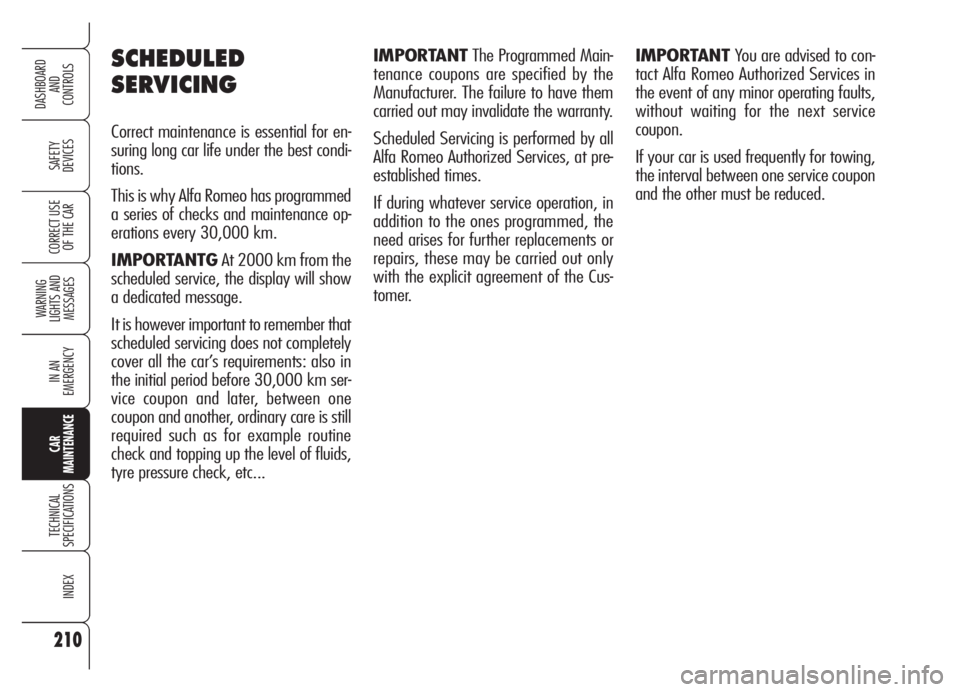
210
SAFETY
DEVICES
WARNING
LIGHTS AND
MESSAGES
IN AN
EMERGENCY
CAR
MAINTENANCE
TECHNICAL
SPECIFICATIONS
INDEX
DASHBOARD
AND
CONTROLS
CORRECT USE
OF THE CAR
SCHEDULED
SERVICING
Correct maintenance is essential for en-
suring long car life under the best condi-
tions.
This is why Alfa Romeo has programmed
a series of checks and maintenance op-
erations every 30,000 km.
IMPORTANTGAt 2000 km from the
scheduled service, the display will show
a dedicated message.
It is however important to remember that
scheduled servicing does not completely
cover all the car’s requirements: also in
the initial period before 30,000 km ser-
vice coupon and later, between one
coupon and another, ordinary care is still
required such as for example routine
check and topping up the level of fluids,
tyre pressure check, etc...IMPORTANTThe Programmed Main-
tenance coupons are specified by the
Manufacturer. The failure to have them
carried out may invalidate the warranty.
Scheduled Servicing is performed by all
Alfa Romeo Authorized Services, at pre-
established times.
If during whatever service operation, in
addition to the ones programmed, the
need arises for further replacements or
repairs, these may be carried out only
with the explicit agreement of the Cus-
tomer.IMPORTANTYou are advised to con-
tact Alfa Romeo Authorized Services in
the event of any minor operating faults,
without waiting for the next service
coupon.
If your car is used frequently for towing,
the interval between one service coupon
and the other must be reduced.
Page 212 of 270
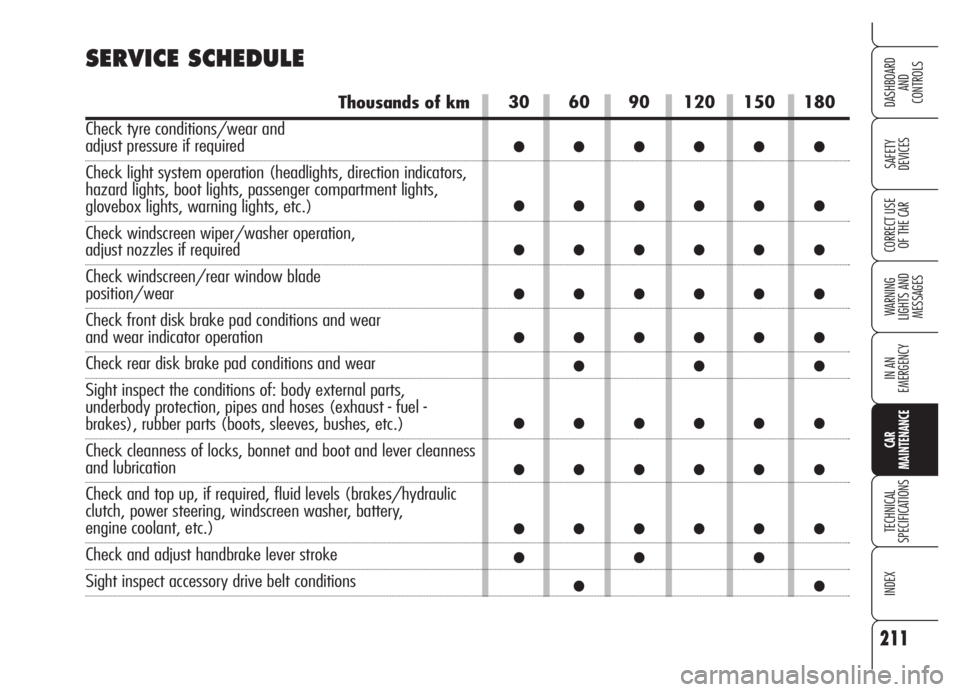
211
SAFETY
DEVICES
WARNING
LIGHTS AND
MESSAGES
IN AN
EMERGENCY
CAR
MAINTENANCE
TECHNICAL
SPECIFICATIONS
INDEX
DASHBOARD
AND
CONTROLS
CORRECT USE
OF THE CAR
30 60 90 120 150 180
●●●●●●
●●●●●●
●●●●●●
●●●●●●
●●●●●●
●●●
●●●●●●
●●●●●●
●●●●●●
●●●
●●
SERVICE SCHEDULE
Thousands of km
Check tyre conditions/wear and
adjust pressure if required
Check light system operation (headlights, direction indicators,
hazard lights, boot lights, passenger compartment lights,
glovebox lights, warning lights, etc.)
Check windscreen wiper/washer operation,
adjust nozzles if required
Check windscreen/rear window blade
position/wear
Check front disk brake pad conditions and wear
and wear indicator operation
Check rear disk brake pad conditions and wear
Sight inspect the conditions of: body external parts,
underbody protection, pipes and hoses (exhaust - fuel -
brakes), rubber parts (boots, sleeves, bushes, etc.)
Check cleanness of locks, bonnet and boot and lever cleanness
and lubrication
Check and top up, if required, fluid levels (brakes/hydraulic
clutch, power steering, windscreen washer, battery,
engine coolant, etc.)
Check and adjust handbrake lever stroke
Sight inspect accessory drive belt conditions
Page 213 of 270

212
SAFETY
DEVICES
WARNING
LIGHTS AND
MESSAGES
IN AN
EMERGENCY
CAR
MAINTENANCE
TECHNICAL
SPECIFICATIONS
INDEX
DASHBOARD
AND
CONTROLS
CORRECT USE
OF THE CAR
Thousands of km
Check exhaust emissions (petrol versions)
Check exhaust emissions/smoke (diesel versions)
Check antievaporation system (petrol versions)
Check engine control system operation
(through diagnosis socket)
Replace accessory drive belt/s
Replace timing belt (diesel versions) (*)
Change spark plugs (petrol versions)
Replace diesel fuel filter (diesel versions)
Change air cleaner cartridge (petrol versions)
Change air cleaner cartridge (diesel versions)
Change front transmission gear oil (3.2 JTS versions)
Change engine oil and oil filter (petrol versions)
(or every 2 years)
Change engine oil and oil filter (diesel versions - DPF)(**)
(or every 2 years)
Change brake fluid (or every 2 years)
Change pollen filter (or every 2 year)
(*) Regardless of the km covered, the timing belt shall be replaced every 4 years for particularly demanding use (cold climates, driving
in the city, idling for a long time) or in any case every 5 years.
(**) Engine oil and oil filter shall actually be changed according to the conditions of use of the car and it is indicated by the relevant
message on the instrument panel display (see section “Warning lights and messages”).
30 60 90 120 150 180
●●●●●●
●●●●●●
●●
●●●●●●
●
●
●
●●●
●●●
●●●●●●
●
●●●●●●
(●)(●)(●)(●)(●)(●)
●●●
●●●●●●
Page 214 of 270
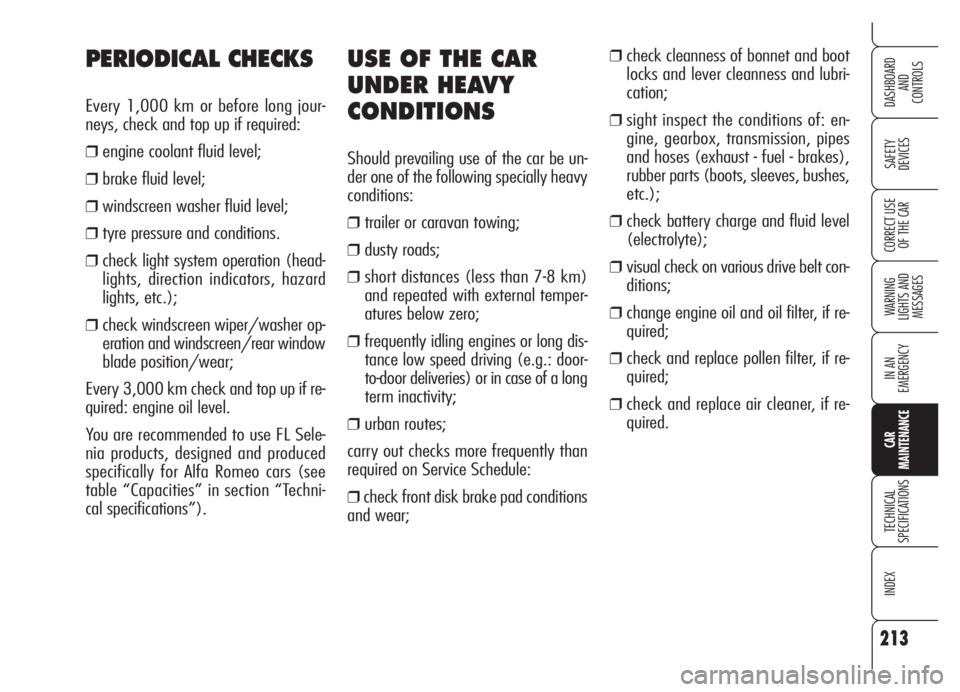
213
SAFETY
DEVICES
WARNING
LIGHTS AND
MESSAGES
IN AN
EMERGENCY
CAR
MAINTENANCE
TECHNICAL
SPECIFICATIONS
INDEX
DASHBOARD
AND
CONTROLS
CORRECT USE
OF THE CAR
USE OF THE CAR
UNDER HEAVY
CONDITIONS
Should prevailing use of the car be un-
der one of the following specially heavy
conditions:
❒trailer or caravan towing;
❒dusty roads;
❒short distances (less than 7-8 km)
and repeated with external temper-
atures below zero;
❒frequently idling engines or long dis-
tance low speed driving (e.g.: door-
to-door deliveries) or in case of a long
term inactivity;
❒urban routes;
carry out checks more frequently than
required on Service Schedule:
❒check front disk brake pad conditions
and wear;
❒check cleanness of bonnet and boot
locks and lever cleanness and lubri-
cation;
❒sight inspect the conditions of: en-
gine, gearbox, transmission, pipes
and hoses (exhaust - fuel - brakes),
rubber parts (boots, sleeves, bushes,
etc.);
❒check battery charge and fluid level
(electrolyte);
❒visual check on various drive belt con-
ditions;
❒change engine oil and oil filter, if re-
quired;
❒check and replace pollen filter, if re-
quired;
❒check and replace air cleaner, if re-
quired.
PERIODICAL CHECKS
Every 1,000 km or before long jour-
neys, check and top up if required:
❒engine coolant fluid level;
❒brake fluid level;
❒windscreen washer fluid level;
❒tyre pressure and conditions.
❒check light system operation (head-
lights, direction indicators, hazard
lights, etc.);
❒check windscreen wiper/washer op-
eration and windscreen/rear window
blade position/wear;
Every 3,000 km check and top up if re-
quired: engine oil level.
You are recommended to use FL Sele-
nia products, designed and produced
specifically for Alfa Romeo cars (see
table “Capacities” in section “Techni-
cal specifications”).
Page 215 of 270

214
SAFETY
DEVICES
WARNING
LIGHTS AND
MESSAGES
IN AN
EMERGENCY
CAR
MAINTENANCE
TECHNICAL
SPECIFICATIONS
INDEX
DASHBOARD
AND
CONTROLS
CORRECT USE
OF THE CAR
CHECKING FLUID
LEVELS
Refer to section Technical Specifications
for fluid amounts.
1.Engine oil - 2.Battery
3.Brake fluid - 4.Windscreen washer
fluid - 5.Engine coolant
6.Power steering fluid
fig. 1 - 2.2 JTS versionsA0F0161m
fig. 2 - 3.2 JTS versionsA0F0038m
Never smoke while
working in the engine
compartment; gas and inflam-
mable vapours may be pre-
sent, with the risk of fire.
WARNING
When topping up take
care not to confuse the
various types of fluids:
they are all incompatible with
one another and could serious-
ly damage the car.
Page 216 of 270
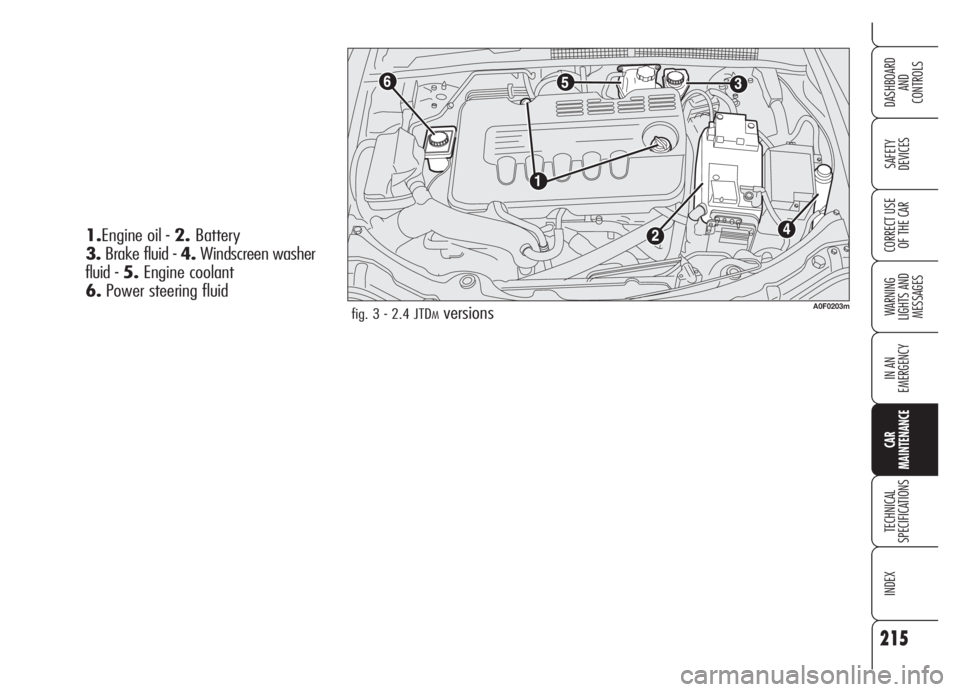
215
SAFETY
DEVICES
WARNING
LIGHTS AND
MESSAGES
IN AN
EMERGENCY
CAR
MAINTENANCE
TECHNICAL
SPECIFICATIONS
INDEX
DASHBOARD
AND
CONTROLS
CORRECT USE
OF THE CAR
fig. 3 - 2.4 JTDMversionsA0F0203m
1.Engine oil - 2.Battery
3.Brake fluid - 4.Windscreen washer
fluid - 5.Engine coolant
6.Power steering fluid
Page 217 of 270

216
SAFETY
DEVICES
WARNING
LIGHTS AND
MESSAGES
IN AN
EMERGENCY
CAR
MAINTENANCE
TECHNICAL
SPECIFICATIONS
INDEX
DASHBOARD
AND
CONTROLS
CORRECT USE
OF THE CARENGINE OIL
Fig. 4: 2.2 JTS versions
Fig. 5: 3.2 JTS versions
Fig. 6: 2.4 JTD
MversionsChecking engine oil
Check the oil level a few minutes (about
5) after the engine has stopped, with
the car parked on level ground.
A0F0018mfig. 4A0F0069mfig. 5A0F0202mfig. 6
Remove the dipstick Aand clean it, put
it back in completely, remove it and
check that the level is within the MIN
andMAXmarks on the dipstick. The
gap between the MINandMAX
marks corresponds to about one litre of
oil.
Page 218 of 270
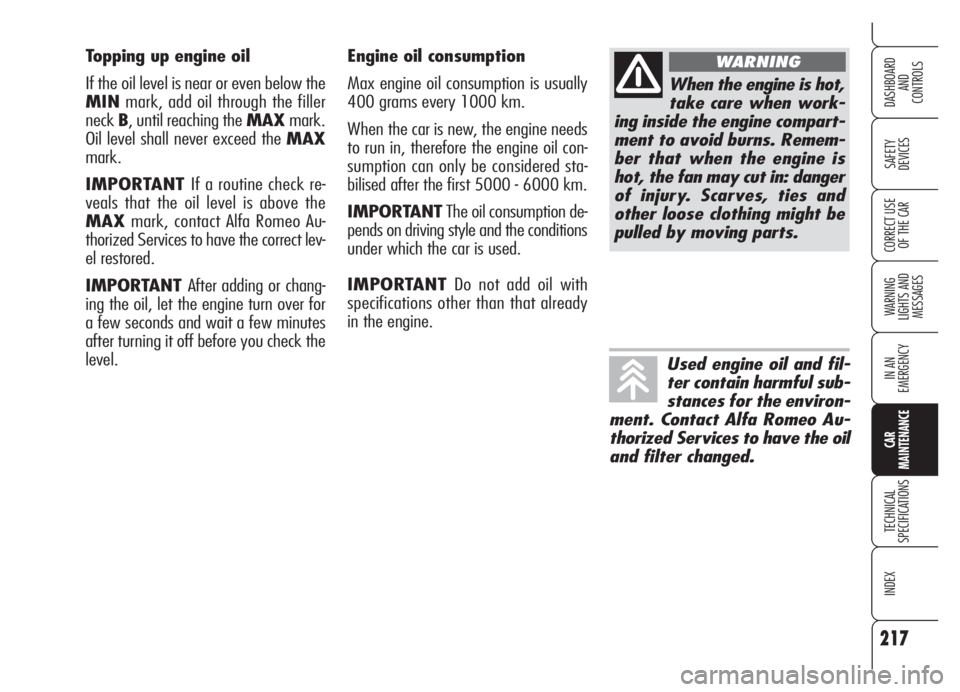
217
SAFETY
DEVICES
WARNING
LIGHTS AND
MESSAGES
IN AN
EMERGENCY
CAR
MAINTENANCE
TECHNICAL
SPECIFICATIONS
INDEX
DASHBOARD
AND
CONTROLS
CORRECT USE
OF THE CAR
Engine oil consumption
Max engine oil consumption is usually
400 grams every 1000 km.
When the car is new, the engine needs
to run in, therefore the engine oil con-
sumption can only be considered sta-
bilised after the first 5000 - 6000 km.
IMPORTANTThe oil consumption de-
pends on driving style and the conditions
under which the car is used.
IMPORTANTDo not add oil with
specifications other than that already
in the engine. Topping up engine oil
If the oil level is near or even below the
MINmark, add oil through the filler
neckB, until reaching the MAXmark.
Oil level shall never exceed the MAX
mark.
IMPORTANT If a routine check re-
veals that the oil level is above the
MAXmark, contact Alfa Romeo Au-
thorized Services to have the correct lev-
el restored.
IMPORTANT After adding or chang-
ing the oil, let the engine turn over for
a few seconds and wait a few minutes
after turning it off before you check the
level.
When the engine is hot,
take care when work-
ing inside the engine compart-
ment to avoid burns. Remem-
ber that when the engine is
hot, the fan may cut in: danger
of injury. Scarves, ties and
other loose clothing might be
pulled by moving parts.
WARNING
Used engine oil and fil-
ter contain harmful sub-
stances for the environ-
ment. Contact Alfa Romeo Au-
thorized Services to have the oil
and filter changed.
Page 219 of 270
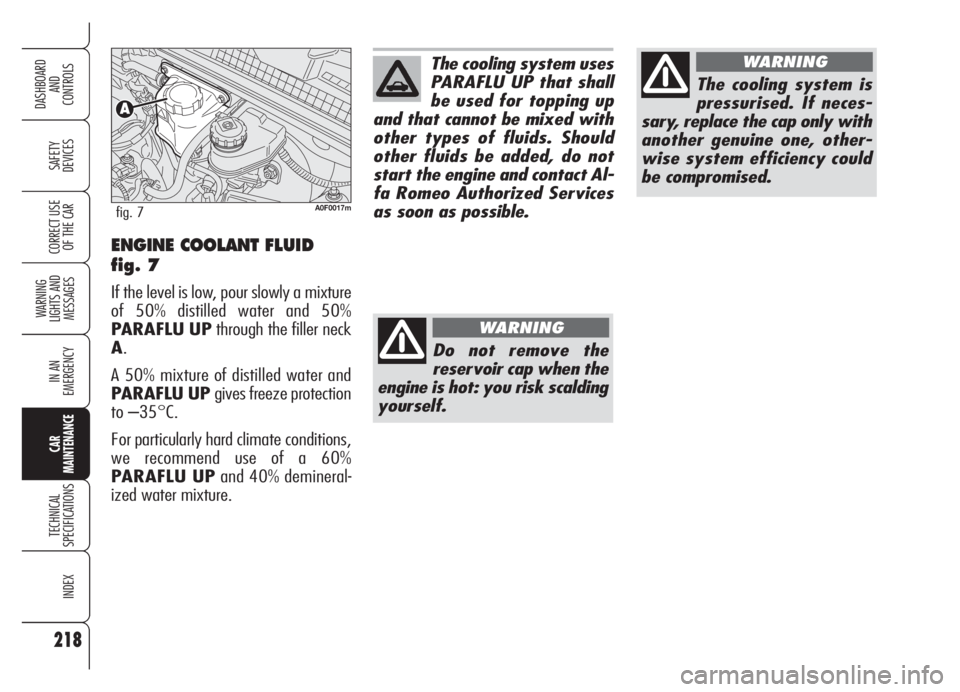
218
SAFETY
DEVICES
WARNING
LIGHTS AND
MESSAGES
IN AN
EMERGENCY
CAR
MAINTENANCE
TECHNICAL
SPECIFICATIONS
INDEX
DASHBOARD
AND
CONTROLS
CORRECT USE
OF THE CAR
The cooling system uses
PARAFLU UP that shall
be used for topping up
and that cannot be mixed with
other types of fluids. Should
other fluids be added, do not
start the engine and contact Al-
fa Romeo Authorized Services
as soon as possible.
Do not remove the
reservoir cap when the
engine is hot: you risk scalding
yourself.
WARNING
The cooling system is
pressurised. If neces-
sary, replace the cap only with
another genuine one, other-
wise system efficiency could
be compromised.
WARNING
ENGINE COOLANT FLUID
fig. 7
If the level is low, pour slowly a mixture
of 50% distilled water and 50%
PARAFLU UPthrough the filler neck
A.
A 50% mixture of distilled water and
PARAFLU UP gives freeze protection
to –35°C.
For particularly hard climate conditions,
we recommend use of a 60%
PARAFLU UPand 40% demineral-
ized water mixture.
A0F0017mfig. 7
Page 220 of 270
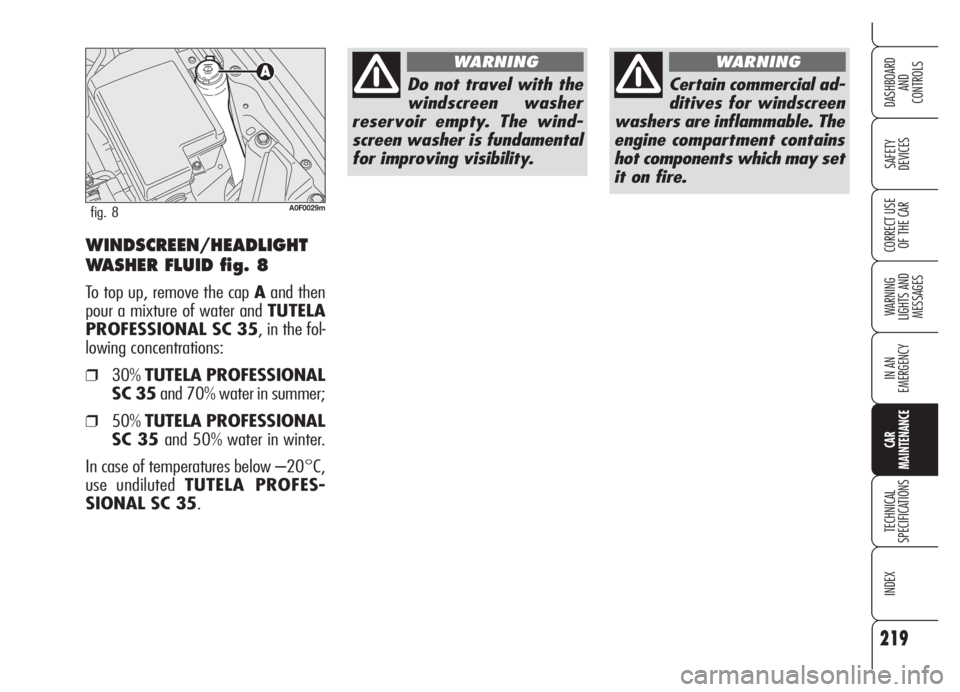
219
SAFETY
DEVICES
WARNING
LIGHTS AND
MESSAGES
IN AN
EMERGENCY
CAR
MAINTENANCE
TECHNICAL
SPECIFICATIONS
INDEX
DASHBOARD
AND
CONTROLS
CORRECT USE
OF THE CARWINDSCREEN/HEADLIGHT
WASHER FLUID fig. 8
To top up, remove the cap Aand then
pour a mixture of water and TUTELA
PROFESSIONAL SC 35, in the fol-
lowing concentrations:
❒30%TUTELA PROFESSIONAL
SC 35and 70% water in summer;
❒50%TUTELA PROFESSIONAL
SC 35 and 50% water in winter.
In case of temperatures below –20°C,
use undiluted TUTELA PROFES-
SIONAL SC 35.
A0F0029mfig. 8
Do not travel with the
windscreen washer
reservoir empty. The wind-
screen washer is fundamental
for improving visibility.
WARNING
Certain commercial ad-
ditives for windscreen
washers are inflammable. The
engine compartment contains
hot components which may set
it on fire.
WARNING